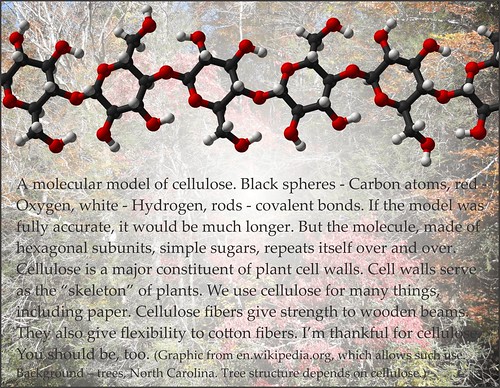Cellulose is a polymer. That is, it is made of a smaller molecule, repeated many times. The graphic above shows a molecular model of cellulose, but it's only part of a real molecule. Real cellulose molecules have those hexagonal subunits repeated as many as thousands of times. Such long molecules make up fibers. The graphic comes from the Wikipedia article on cellulose. The Wikipedia allows such use of this graphic. The background photo is of trees in North Carolina. Tree structure, including trunks, branches, twigs, roots, leaves, fruit and flowers, wouldn't be possible without cellulose.
Why is cellulose important? The main reason is that it makes up most of the structure of plant cell walls. Without plants, we would have no food. The animals who are our companions, or help to make our lives easier, and who furnish us with meat, milk, eggs, leather, and many other products, wouldn't have food, either. Without plants, we would be missing building materials, cotton textiles, fuel (including fossil fuel), many medicines, special food substances like coffee, sugar, tea and chocolate, ornamental and shade plants, and many other useful, even necessary items.
Plant cell walls provide plants with their structure. Plants have no bones, but each cell, as it were, has its own skeleton. (That type of structure means that plants can't move around, whereas animals can. Although we have rigid bones, we also have flexible muscles, which allow us to walk, fly or swim. Plants are rigid all over.) Cellulose is used to make paper and cotton. It furnishes much of the fiber, which is important for our diet, even though we can't really use it for fuel. (Cows and termites have special microorganisms in their guts that can break down cellulose, so that these animals can get food energy from it. We don't.)
So. Consider a world with no paper. And no cotton. And no chocolate. And no flowers. And no food. It wouldn't be much of a world.
Cellulose, depending on how it is treated, and what's combined with it, can be the basis of wooden bridges that can hold freight trains, or flexible garments made of cotton.
In a previous post, the importance of the bonding of Carbon atoms was discussed. Because Carbon atoms can form four covalent bonds, complex structures like cellulose are possible. I believe, but cannot prove, that God designed Carbon in this way. (It can't be disproved, either.)
I'm thankful for cellulose. I hope you are, too.

Musings on science, the Bible, and fantastic literature (and sometimes basketball and other stuff).
God speaks to us through the Bible and the findings of science, and we should listen to both types of revelation.
The title is from Psalm 84:11.
The Wikipedia is usually a pretty good reference. I mostly use the World English Bible (WEB), because it is public domain. I am grateful.
License
I have written an e-book, Does the Bible Really Say That?, which is free to anyone. To download that book, in several formats, go here.

The posts in this blog are licensed under a Creative Commons Attribution-NonCommercial-ShareAlike 3.0 Unported License. You can copy and use this material, as long as you aren't making money from it. If you give me credit, thanks. If not, OK.

The posts in this blog are licensed under a Creative Commons Attribution-NonCommercial-ShareAlike 3.0 Unported License. You can copy and use this material, as long as you aren't making money from it. If you give me credit, thanks. If not, OK.
Tuesday, November 25, 2014
I'm thankful for cellulose. You should be, too.
Labels:
Carbon bonds,
cell walls,
cellulose,
fiber,
gratitude,
plant cells,
polymer,
thankfulness,
Thanks
Subscribe to:
Post Comments (Atom)

No comments:
Post a Comment